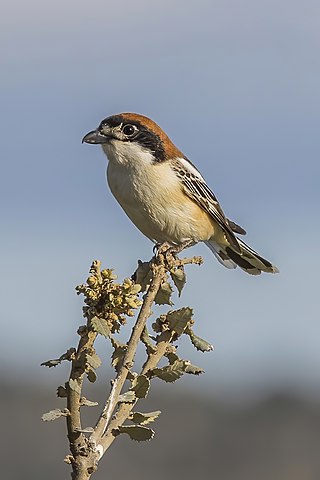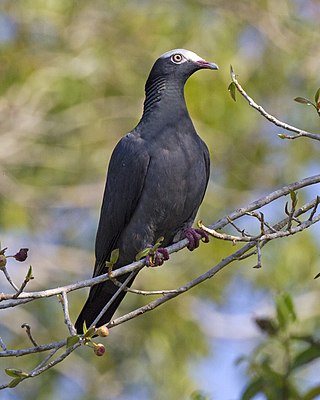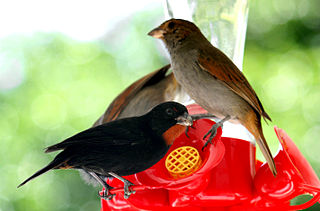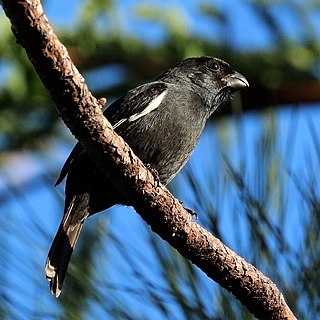
The woodchat shrike is a member of the shrike family Laniidae. It can be identified by its red-brown crown and nape. It is mainly insectivorous and favours open wooded areas with scattered trees such as orchards, particularly when there is bare or sandy ground. The woodchat shrike breeds in southern Europe, the Middle East and northwest Africa, and winters in tropical Africa.

The common shelduck is a waterfowl species of the shelduck genus, Tadorna. It is widespread and common in the Euro-Siberian region of the Palearctic, mainly breeding in temperate and wintering in subtropical regions; in winter, it can also be found in the Maghreb.

The summer tanager is a medium-sized American songbird. Formerly placed in the tanager family (Thraupidae), it and other members of its genus are now classified in the cardinal family (Cardinalidae). The species's plumage and vocalizations are similar to other members of the cardinal family.

The black-hooded oriole is a member of the oriole family of passerine birds and is a resident breeder in tropical southern Asia from India and Sri Lanka east to Indonesia.

The white-crowned pigeon is a fruit and seed-eating species of bird in the dove and pigeon family Columbidae. It is found primarily in the Caribbean.

The black-faced grassquit is a small bird. It is recognized as a tanager closely related to Darwin's finches. It breeds in the West Indies except Cuba, on Tobago but not Trinidad, and along the northern coasts of Colombia and Venezuela.

The blue grosbeak, is a medium-sized North American passerine bird in the cardinal family Cardinalidae. It is mainly migratory, wintering in Central America and breeding in northern Mexico and the southern United States. The male is blue with two brown wing bars. The female is mainly brown with scattered blue feathers on the upperparts and two brown wing bars.

The Jamaican mango is a species of hummingbird in the subfamily Polytminae. It is endemic to Jamaica.

The red lory is a species of parrot in the family Psittaculidae. It is the second-most commonly kept lory in captivity, after the rainbow lorikeet.

The blue-headed quail-dove, or blue-headed partridge-dove, is a species of bird in the pigeon and dove family Columbidae. It is monotypic within the subfamily Starnoenadinae and genus Starnoenas.

The red-tailed vanga is a species of bird in the family Vangidae. It is endemic to Madagascar.

The Caribbean elaenia is a species of bird in the family Tyrannidae found in the West Indies and parts of Central America. Its natural habitats are tropical and subtropical dry broadleaf forest, subtropical or tropical moist lowland forest, and heavily degraded former forest.

The orangequit is a species of passerine bird in the tanager family Thraupidae and is the only member of the genus Euneornis. It is endemic to Jamaica where its natural habitats are subtropical or tropical moist lowland forests and heavily degraded former forest.

The lesser Antillean bullfinch is a species of bird in the family Thraupidae. It is found in Saint Barth, Saint Martin, Anguilla, Antigua and Barbuda, Dominica, Grenada, Guadeloupe, Martinique, Montserrat, Netherlands Antilles, Saint Kitts and Nevis, Saint Lucia, Saint Vincent and the Grenadines, the British Virgin Islands, and the U.S. Virgin Islands.

The Greater Antillean bullfinch is a species of bird in the family Thraupidae.

Melopyrrha is a genus of passerine birds in the tanager family Thraupidae. It is made up of four extant species endemic to the Greater Antilles, along with 1 possibly extinct species from the island of Saint Kitts in the Lesser Antilles.

The fulvous-crested tanager is a species of bird in the family Thraupidae, the tanagers.

The spotted tanager is a species of bird in the tanager family Thraupidae. It is found in Bolivia, Brazil, Ecuador, French Guiana, Guyana, Peru, Suriname, and Venezuela. Its natural habitats are subtropical or tropical moist lowland forests and subtropical or tropical moist montane forests.

The opal-rumped tanager is a species of bird in the family Thraupidae. It is found in the Amazon and Atlantic Forest of South America. The population of the Atlantic Forest has a far paler chest than the other populations, and has often been considered a separate species as the silvery-breasted tanager. Today most authorities treat it as a subspecies of the opal-rumped tanager.

The Cuban grassquit is a small bird in the tanager family Thraupidae. It is endemic to Cuba.






















